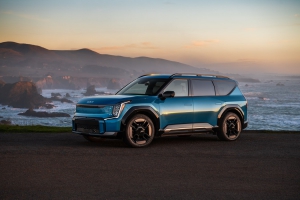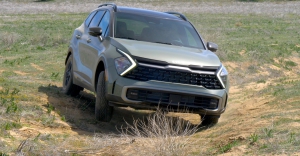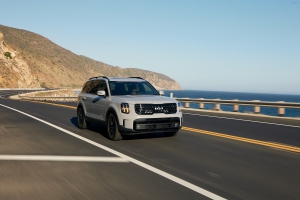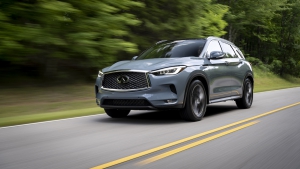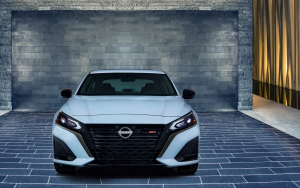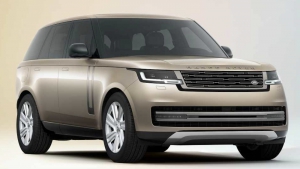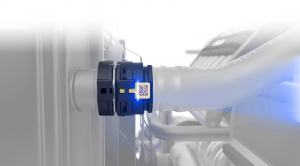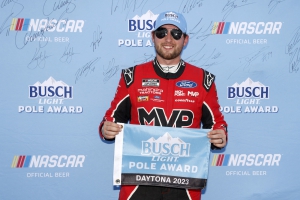
Matt M. Myftiu
Matt Myftiu has been a journalist for two decades with a focus on technology, NASCAR and autos.
Three-row Kia EV9 is the best electric vehicle of 2024
As the move toward electrification continues, it takes a lot to stand out amid the constant stream of new vehicle announcements.
One way to distinguish yourself is to do things a little bigger, like Kia has done with its impressive 2024 Kia EV9 three-row SUV, which debuts as one of the few options for EV buyers seeking a larger vehicle to fit bigger families and more cargo.
A bit larger than Kia’s highly popular Telluride SUV, the EV9 offers stunning design inside and out, excellent range, and an overall package that make it a leader in an EV category with only a handful of options from brands like Rivian, Tesla and Mercedes-Benz.
Kia is making a bold commitment by entering this larger EV segment, while other brands are still hesitant to jump into the EV realm with larger offerings. (Note: Kia also has multiple other EVs of various sizes scheduled to come out in the next two years as well)
I recently spent some time behind the wheel of an 2024 Kia EV9 GT-Line model, and I’m back with a full report on what is clearly the best EV I’ve tested so far in 2024.
2024 Kia Sportage delivers sharp design, roomy interior, off-road friendly model
Kia’s SUV lineup has become one of the strongest in the automotive landscape, and that’s true not only because of larger vehicles like the Telluride, but also its smaller crossover options.
The compact Kia Sportage SUV is one of those offerings, slotting between Kia’s Seltos and Sorento in terms of size, and competes against some heavy hitters such as Ford Escape, Hyundai Tucson, Honda CR-V and Toyota RAV4.
I recently spent some time behind the wheel of a 2024 Kia Sportage X-Pro Prestige AWD, a more off-road friendly version of the Sportage, and I’m back with a full report on how it holds up in the compact SUV battlefield.
Versatile, tech-savvy 2024 Kia Telluride shines among three-row SUVs
There’s been much said about the Kia Telluride since it debuted in the 2020 model year.
And most of what’s been said has been positive.
This three-row, midsize SUV (which is slightly larger than Kia’s Sorento SUV) has been all the rage, quickly becoming one of the brand’s top sellers by delivering a strong overall package of looks, power, tech and versatility for families.
Delivering a look and feel that are more upscale than you would likely expect from Kia, it’s clear that the Telluride is not a flash in the pan, and will continue to be a contender in the segment for many years to come.
I recently tested the 2024 Telluride (specifically the SX-Prestige X-Pro model), and I’m back with a full rundown on how it’s holding up a half-decade into its existence — as it battles other big-name SUVs such as the Honda Pilot, Hyundai Palisade and Ford Explorer.
2024 Nissan Rogue updates tech, continues to impress
The numbers don’t lie.
And the numbers show that the Nissan Rogue is one of the top-selling vehicles in the country.
In terms of SUV sales, it is topped only by the Toyota RAV4, Tesla Model Y and Honda CR-V, and it has more impressive numbers than every other SUV available, with more than 270,000 sold in 2023.
Within Nissan’s lineup, it’s also by far the most popular option — doubling sales of the Altima.
The Rogue achieves this success by offering strong fuel mileage, an attractive look and a strong tech setup. It’s not trying to be the most exciting or sporty SUV, instead offering a solid, user-friendly overall package that will appeal to both families and individuals.
Upgrades have been made to the design and tech in the 2024 Nissan Rogue, including Google features now being built into its tech setup. I recently spent some time behind the wheel of the 2024 Rogue (a Platinum trim model), and I’m back with a full report.
2024 Infiniti QX50 is a roomy, affordable compact luxury SUV
The luxury car world is one with a wide variety of competitors – some dealing in high volumes in the U.S. and others on the lower end.
One of the brands that doesn’t have a huge market share but still offers some compelling vehicles is Infiniti, the luxury division of Nissan that has been offered in the U.S. for more than 30 years.
On the smaller end of their SUV lineup, Infiniti offers a couple vehicles — the QX50 and the QX55 (QX50 being a more traditional compact SUV, and QX55 featuring a more sporty and coupe-style design). Part of their appeal is their pricing starts at less than some of their major luxury competitors — making them appealing to buyers with a budget.
I recently tested a 2024 Infiniti QX50, and I’m back with a full report on how it compares in today’s luxury car market.
2024 Nissan Altima holds its own in midsize sedan battle
With more automotive brands backing out of the sedan segment each year, the ones who are sticking it out continue to wage a tough battle for market share, fighting among each other for less total percentage each year.
Once the go-to for families, sedans are now being pushed aside in favor of SUVs and trucks, but they’re not quite dead yet.
Among the handful of brands still competing in the sedan battle is Nissan, whose offerings include the midsize Altima sedan — which goes head-on against giants such as the Honda Accord and Toyota Camry and has been sold for more than 30 years.
After a makeover for 2023 when its sixth generation was unveiled, the Altima carries over mostly unchanged for the 2024 model year.
I recently spent some time behind the wheel of a 2024 Nissan Altima SL, and I’m back with a full report on my experience and how the Altima holds up against other midsize sedans.
Powerful, classy Range Rover is the pinnacle of ultra-luxury SUVs
There’s no doubt that when listing the most iconic vehicles in modern history, the Range Rover — the most well-known offering in the Land Rover family of vehicles — is going to be a name that comes up consistently.
A vehicle unlike any other that is literally associated with royalty, this ultra-luxurious ride has an elegant and bold look, while also offering tremendous power and off-road capabilities and a family-friendly setup — a truly rare feat to achieve.
The number of top-shelf competitors in the Range Rover’s class is quite limited, including a Maybach SUV offering from Mercedes-Benz, the Bentley Bentayga, and if you stretch the category you can also include vehicles like the Jeep Grand Wagoneer, Lexus LX, Cadillac Escalade and BMW X7, which are nice options but not quite as upscale.
I recently tested a three-row Range Rover SE (long-wheel base version with room for 7 passengers), and I’m back with a full report.
Gene Haas to keep one Cup series charter, two Xfinity Series teams, under name Haas Factory Team
While Stewart-Haas Racing as we know it will end after 2024, team owner Gene Haas will continue on a leaner scale in the sport.
Haas will keep one NASCAR Cup Series legacy charter from Stewart-Haas and operate a two-car NASCAR Xfinity Series team. The new enterprise will be known as Haas Factory Team.
“My commitment to motorsports hasn’t changed, just the scope of my involvement,” Haas said. “Operating a four-car Cup Series team has become too arduous but, at the same time, I still need a platform to promote Haas Automation and grow HaasTooling.com.
“Maintaining my presence in Cup allows Haas Automation to compete at NASCAR’s highest level, which is important to our customers and distributors. The Xfinity Series program provides a full weekend experience for our guests, and it delivers added depth and scale to our overall operation.”
Joe Custer will be the president of Haas Factory Team and it will operate out of the existing Stewart-Haas facility in Kannapolis, North Carolina. Drivers and team partners will be announced in the lead up to the 2025 NASCAR season.
ARaymond: Fluid interfaces and fastening solutions are improving EV thermal management
By Sébastien Frasse-Sombet
Senior Global Product Manager, ARaymond
As the automotive industry continues to evolve and electric vehicles (EVs) become more mainstream, innovations are affecting all vehicle components, including the fasteners and assembly systems used.
One such system is thermal management, a critical element of an EV, with dozens of connection points in each vehicle. The EV and its battery pack must be adequately cooled to ensure safe and efficient operation. It’s essential to secure all fluid lines to avoid leakage inside a battery pack or near the vehicle’s electric components.
Autonomous driving functions are expected to increase this requirement. During autonomous driving, a vehicle’s ADAS computer is cooled by the same liquid that cools the battery. Loss of function can damage the calculator from overheating, potentially leading to an accident. As a result, OEMs are increasing demands for secure connections and product traceability.
In addition to helping automakers ensure EVs are as safe as possible, advances in fastener solutions for thermal management are also making the process of building EVs more ergonomic — allowing suppliers to tailor and customize parts for each requirement. The result is a better and safer electric vehicle for drivers.
Safety first
A key element of thermal management fluid interfaces is a reliable locking mechanism. This comes in many forms. Some quick connectors, when inserted, can provide visual, tactile, and audible confirmation — so an installer feels and hears when the connection is made.
Other options include the use of QR (quick-response) or DMC (datamatrix) codes, allowing for better traceability. QR codes are two-dimensional matrix barcodes invented in the mid-90s. They were initially created to track automotive parts during the assembly process and became widely used in consumer products in the 2000s.
DMC is also two-dimensional but square and can store a significant amount of information. For this reason, it’s becoming the preferred method of encoding data.
In either case, this data is available for review in the event of any concerns or maintenance issues with the vehicles. Such verification is critical for safety and traceability reasons, making identifying possible root causes of potential problems easier. Secured fasteners for thermal management systems and fluid line connections keep EV drivers and passengers safer, an essential goal for all automakers.
Better health
Advanced connection systems for EVs also mean improvements for the technicians building and installing these fastening solutions. This is because many connectors used on EVs have become low-push quick connectors — which means less insertion effort is required during installation.
This is important as it saves plant workers potential repetitive strain or musculoskeletal injuries from accessing the installation point continually throughout their shift.
Typically, these installation points can be challenging to access, increasing the chance of a faulty connection, which can lead to vehicle component damage or poor reliability. There’s also a significant number of connectors required in every EV.
Additionally, larger fluid lines are used, so a proper connection requires more force. When done manually, ergonomics are a concern. By simplifying the architecture of fastener installation, OEMs provide a safer workplace for employees assembling EVs while improving vehicle reliability.
Versatile designs
Automakers have specific requirements and specifications for their electric vehicle lineup. Special features and custom component designs have become essential. One such feature is lightweighting, especially for EVs where vehicle weight and range are significant.
Many custom designs are compressed in size so they fit into tight spaces. The trend toward smaller connectors allows for better space optimization and reduced weight. Part materials can be plastic or metal to serve the connection point best, whether for the battery pack or to seal in individual battery cells.
Suppliers can work with OEMs to offer environmentally friendly materials, eco-friendly designs, and a full lifecycle analysis of the parts. This allows suppliers to play an important role in helping OEMs reach their CSR goals. Custom designs further allow connections to be built for ease of assembly and serviceability, as well as with sustainability in mind. An improved sustainability model minimizes the OEM’s footprint while maximizing coolant flow.
While EVs are presenting new fastening challenges due to a focus on thermal management, the industry is rising to the challenge with products that improve vehicle safety, address ergonomic issues at the assembly level, and create customized solutions that will benefit the automakers and the environment.
Sébastien Frasse-Sombet is a Senior Global Product Manager for global automotive supplier ARaymond.
Martin Truex Jr. retirement announcement kicks NASCAR silly season into high gear
With the announcement of Martin Truex Jr’s retirement from full-time Cup racing officially announced (after years of reporters asking him about it), now comes the fun part: We get to see the dominoes fall.
Silly Season is in full effect, and here are my predictions on how things will play out in the months to come.
No. 19 car: Joe Gibbs Racing
So many possibilities here. There are rumors that Chase Briscoe is the front-runner, which makes sense since he’s a proven winner who is young with a lot of strong years ahead of him. There are also fans who would love to see a return from JGR’s past discards. Could there be a Kyle Busch reunion, since his new team at RCR has been struggling this year? What about Erik Jones, now floundering at Legacy Motor Club? And don’t leave out the young Toyota drivers waiting in the wings — John Hunter Nemechek was once a shoe-in for this ride, but now that may not be the case. Corey Heim and Chandler Smith are also solid young talents eyeing the ride.
So basically this is the prime seat for 2025, and everyone wants it. If it goes to Briscoe that’s a major coup for Toyota to pull one of Ford’s promising young drivers. And I believe this is the route they’ll go, leaving Nemechek and Heim to look to other teams like an expanding 23XI for ride options.
Stewart-Haas refugees: Where will they go?
The big question this year — with a four-car team shutting down (and likely its Xfinity program), where will all their drivers go?
Chase Briscoe — LIkely going to the 19 car, but other options within the Ford camp include a third car for RFK (if they expand) or Wood Brothers’ 21 car (when Harrison Burton is inevitably let go due to underperforming).
Noah Gragson and Josh Berry — I’m lumping these two together because I can see them going to the same place: Front Row Motorsports. With a newly announced third charter, and Michael McDowell already leaving for Spire, there is only one spot filled right now (Todd Gilliland). Gragson and Berry are two promising young drivers that should be high on Front Row’s target list. And if they’re smart, they’ll keep Rodney Childers on as Berry’s crew chief.
Ryan Preece — Preece has worked his way up to Cup after showing his talent in the lower series, and he’s definitely got talent. But without bringing a lot of sponsor funding, I can see him getting sidelined from Cup in 2025. Whether he makes it back up the ladder down the road is not a certainty.
Riley Herbst — Considering that he brings daddy’s money with him, finding another ride shouldn’t be a problem for Herbst. And he should stay in Xfinity at least another year, as I don’t believe he’s ready for the much tougher Cup series.
Cole Custer — I can see him getting the Wood Brothers ride in Cup if Briscoe goes to the 19. But if the Cup slots are all filled, he is strong enough of a driver to land a quality ride in the Xfinity Series as he continues to grind his way up to the top series for another go-around.
Other thoughts
— Zane Smith has struggled mightily in the 71 car this year, and will be looking for a new ride for 2025. He might be one of the drivers better suited by dropping down to the Xfinity Series rather than struggling again next year at another bad Cup team.
— Austin Dillon should make the choice to step down from his ride at RCR. He’s only damaging the team’s legacy with his abysmal performance, and would be better suited for a management role in his grandfather’s company. It’s unlikely, but that move would open up yet another high-profile ride for the many talented drivers seeking a new spot.
— It would seem logical to me that once it’s announced that Trackhouse will receive one of the SHR charters (Front Row has claimed one officially, and rumors are that 23XI and Trackhouse each have one too; TBD on the fourth), Shane Van Gisbergen should be given that ride. He’s a clear talent on the road courses, and has shown promise on the ovals. Moving him to Cup is a no-brainer to me.
---
Follow AutoTechReviews on Instagram at @autotechreviews, and on Twitter @AutoTechReview. Follow Matt Myftiu on Twitter @MattMyftiu.
News Categories
Popular Tags
Search Reviews by Make

AutoTechReviews is your home for In-depth reviews of the latest cars, trucks, and SUVs; information on all the emerging vehicle technology; and breaking news from the world of NASCAR and other motorsports.
